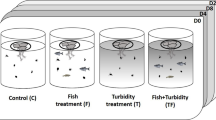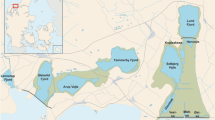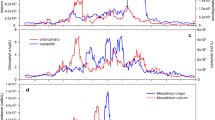Abstract
Here we report on a mesocom study performed to compare the top-down impact of microphagous and macrophagous zooplankton on phytoplankton. We exposed a species-rich, summer phytoplankton assemblage from the mesotrophic Lake Schöhsee (Germany) to logarithmically scaled abundance gradients of the microphagous cladoceran Daphnia hyalina×galeata and of a macrophagous copepod assemblage. Total phytoplankton biomass, chlorophyll a and primary production showed only a weak or even insignificant response to zooplankton density in both gradients. In contrast to the weak responses of bulk parameters, both zooplankton groups exerted a strong and contrasting influence on the phytoplankton species composition. The copepods suppressed large phytoplankton, while nanoplanktonic algae increased with increasing copepod density. Daphnia suppressed small algae, while larger species compensated in terms of biomass for the losses. Autotrophic picoplankton declined with zooplankton density in both gradients. Gelatinous, colonial algae were fostered by both zooplankton functional groups, while medium-sized (ca. 3,000 µm3), non-gelatinous algae were suppressed by both. The impact of a functionally mixed zooplankton assemblage became evident when Daphnia began to invade and grow in copepod mesocosms after ca. 10 days. Contrary to the impact of a single functional group, the combined impact of both zooplankton groups led to a substantial decline in total phytoplankton biomass.





Similar content being viewed by others
References
Abrams PA (1993) Effect of increased productivity on the abundance of trophic levels. Am Nat 141:351–371
Adrian R, Schneider-Olt B (1999) Top-down effects of crustacean zooplankton on pelagic microorganisms in a mesotrophic lake. J Plankton Res 21:2175–2190
Bautista B, Harris RP, Tranter PRG, Harbour D (1992) In situ copepod feeding and grazing rates during a spring bloom dominated by Phaeocystis sp. in the English Channel. J Plankton Res 14:691–703
Bottrell HH, et al. (1976) A review of some problems in zooplankton production studies. Norw J Zool 24:419–456
Burns CW, Schallenberg M (1996) Relative impact of cladocerans, copepods and nutrients on the microbial food web of a mesotrophic lake. J Plankton Res 18:683–714
Carpenter SR, Kitchell JF, Hodgson DR (1985) Cascading trophic interactions and lake productivity. BioScience35:634–639
DeMott WR (1986) The role of taste in food selection by freshwater zooplankton. Oecologia 69:334–340
DeMott WR (1988) Discrimination between algae and artificial particles by freshwater and marine copepods. Limnol Oceanogr 33:397–408
Doak DF, Bigger D, Harding EK, Marvier MA, O'malley RE, Thomson E (1998) The statistical inevitability of stability-diversity relationships in community ecology. Am Nat 151:264–276
Fussmann G (1996) Die Rolle der Rotatorien im Pelagial eines mesotrophen Sees durch Bottom-up und Top-down Prozesse: Freilandbeobachtungen und Enclosure-Experimente. Diploma thesis. University of Kiel, Kiel
Geller W, Müller H. (1981) The filtration apparatus of cladocera: filter mesh sizes and their implications on food selectivity. Oecologia 49:316–321
Gliwicz ZM (1980) Filtering rates, food size selection, and feeding rates in cladocerans – another aspect of interspecific competition in filter-feeding zooplankton. In: Kerfoot WC (ed) Evolution and ecology of zooplankton communities. University of New England Press, Hanover, N.H., pp 282–291.
Hairston NG, Smith FE, Slobodkin LB (1960) Community structure, population control, and competition. Am Nat 94:421–425
Hillebrand H, Dürselen CD, Kischtel D, Pollingher U, Zohary T (1999) Biovolume calculations for pelagic and benthic microalgae. J Phycol 35:403–424
Hulot FD, Lacroix G, Lescher-Moutoué F, Loreau M (2000) Functional diversity governs ecosystem response to nutrient enrichment. Nature 405:340–344
Jürgens K (1994) Impact of Daphnia on planktonic microbial food webs. A review. Mar Microb Food Webs 8:295–324
Kiefer F (1978) Freilebende Copepoda. Die Binnengewässer, vol 26/2. Schweizerbarth, Stuttgart
Kleppel GS (1993) On the diet of calanoid copepods. Mar Ecol Prog Ser 99:183–195
Lampert W (1978) Climatic conditions and planktonic interactions as factors controlling the regular succession of spring algal bloom and extremely clear water in Lake Constance. Verh Int Verein Limnol 20:969–974
Lampert W (1988) The relationships between zooplankton biomass and grazing: a review. Limnologica 19:11–20
Loreau M (2000) Biodiversity and ecosystem fuctioning: recent theoretical advances. Oikos 91:3–17
McCann KS (2000) The diversity-stability debate. Nature 405:233
Naeem S, Li S (1997) Biodiversity enhances ecosystem reliability. Nature 390:507–509
Nalewajko C (1966) Dry weight, ash and volume data for some freshwater planktonic algae. J Fish Res Bd Can 23:1285–1287
Oksanen L, Fretwell SD, Arruda J, Niemela P (1981) Exploitation ecosystems in gradients of primary productivity. Am Nat 118:240–261
Pace ML, Cole JJ, Carpenter SR, Kitchell JF (1999) Trophic cascades revealed in diverse ecosystems. Trends Ecol Evol 14:483–488
Porter KG (1976) Enhancement of algal growth and productivity by grazing zooplankton. Science 192:1332–1334.
Porter KG, Feig YS (1980) The use of DAPI for identifying and counting aquatic microflora. Limnol Oceanogr 25:943–947
Power ME (1992) Top down and bottom up forces in food webs: do plants have primacy? Ecology 73:733-746
Santer B (1990) Lebenszyklusstrategien cyclopoider Copepoden. PhD thesis. University of Kiel, Kiel
Santer B (1994) Influences of food type and concentration on the development of Eudiaptomus gracilis and implications for the interactions between calanoid and cyclopoid copepods. Arch Hydrobiol 131:141–159
Shapiro J, Wright DI (1984) Lake restoration by biomanipulation: Round Lake, Minnesota, the first two years. Freshwater Biol 14:371–383
Sommer F, Stibor H, Sommer U, Velimirov B (2000) Grazing by mesozooplankton from Kiel Bight, Baltic Sea, on different sized algae and natural size fractions. Mar Ecol Prog Ser 199:43–53
Sommer U, Stibor H (2002) Copepoda – Cladocera – Tunicata: the role of three major mesozooplankton groups in pelagic food webs. Ecol Res 17:161–174
Sommer U, Gliwicz ZM, Lampert W, Duncan A (1986) The PEG-model of seasonal succession of planktonic events in lakes. Arch Hydrobiol 106:433–471
Sommer U, Sommer F, Santer B, Jamieson C, Boersma M, Becker C, Hansen T (2001) Complementary impact of copepods and cladocerans on phytoplankton. Ecol Lett 4:545–550
Steemann-Nielsen E (1952) The use of radioactive carbon (C-14) for measuring organic production in the sea. J Conserv Int Explor Mer 18:117-140
Sterner RW (1989) The role of grazers in phytoplankton succession. In: Sommer U (ed) Plankton ecology. Succession in plankton communities. Springer, Berlin Heidelberg New York, pp 107–170
Stoecker DH, Capuzzo JM (1990) Predation on protozoa and its importance to zooplankton. J Plankton Res 12:891–908
Strong DR (1992) Are trophic cascades all wet? Differentiation and donor control in diverse ecosystems. Ecology 73:747–754
Utermöhl H (1958) Zur Vervollkommnung der quantitativen Phytoplankton Methodik. Mitt Int Verein Limnol 9:1–39
Yachi S, Loreau M (1999) Biodiversity and ecosystem productivity in a fluctuating environment: the insurance hypothesis. Proc Natl Acad Sci USA 96:1463–1468
Acknowledgements
The experiments were sponsored by the Deutsche Forschungsgemeinschaft. Technical support by the staff of the Institut für Meereskunde at Kiel and the Max-Planck-Institute of Limnology at Plön is gratefully acknowledged.
Author information
Authors and Affiliations
Corresponding author
Rights and permissions
About this article
Cite this article
Sommer, U., Sommer, F., Santer, B. et al. Daphnia versus copepod impact on summer phytoplankton: functional compensation at both trophic levels. Oecologia 135, 639–647 (2003). https://doi.org/10.1007/s00442-003-1214-7
Received:
Accepted:
Published:
Issue Date:
DOI: https://doi.org/10.1007/s00442-003-1214-7




